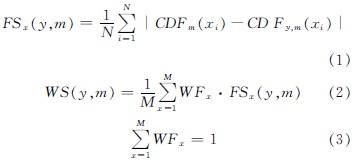基金项目:“十三五”国家重点研发计划基金资助项目(No.2018YFC0704500); 陕西省教育厅科研计划项目基金资助项目(No.19JS043)
第一作者:付昱曦(1996-),女,硕士生,主要从事建筑气候与建筑节能研究.E-mail:fuyuxi0919@163.com 通讯作者:李红莲(1980-),女,高级工程师,研究生导师,主要从事建筑气候与建筑节能研究.E-mail:lihonglian_lhl@163.com
(1.西安建筑科技大学 信息与控制工程学院,陕西 西安710055; 2.西安建筑科技大学 建筑学院,陕西 西安710055)
(1.School of Information and Control Engineering, Xi'an Univ. of Arch. & Tech., Xi'an 710055, China; 2.College of Architecture, Xi'an Univ. of Arch. & Tech., Xi'an 710055, China)
typical meteorological year; acquisition methods; energy consumption simulation
DOI: 10.15986/j.1006-7930.2021.01.020
典型气象年(Typical Meteorological Year,TMY)是建筑模拟中评估能耗的重要资料,它作为能耗模拟软件的基础数据,其输入气象数据的准确性紧密影响着能耗模拟的结果.TMY的挑选需要长期、连续的气象要素记录,但是在中小城镇中不具备这种条件,导致无法使用计算方法生成当地的TMY,从而影响能耗模拟评估.针对这种情况,采用不同途径来获取TMY显得尤为重要.
近几年,我国在这方面取得很大研究成果.2012年,张晴原等人从1995-2005年选取了360个地区的标准气象年数据[1].2015年,李红莲等人梳理了国内外TMY生成方法和逐时气象数据处理方法[2],并指出气象参数选取影响TMY结果的准确性[3],通过对比不同TMY生成方法对建筑能耗影响,指出了适合西安地区的TMY生成方法[4].同年,香港学者利用遗传算法生成适用不同气候条件下的TMY[5].2016年,李红莲等人提出了TMY室外气象参数的选取方法[6].2017年,杨柳等人提出适应我国建筑设计的气象参数的逐时化分析方法[7],刘大龙等人通过分析建筑能耗各气象参数的敏感性系数,得出温度对采暖和空调能耗的影响最大[8].同年,侯立强等人通过比较成都地区各气象参数月均值变化和能耗模拟结果[9],发现当地办公建筑能耗与各气象参数间没有明显规律性.同年,清华大学学者通过比较中国不同气候区主要城市TMY数据与55 a实际天气数据[10],得出寒冷地区的长期能源使用量与采用TMY得出的结果相差很大.同年,熊明明等人发现了气候变化影响TMY数据[11],采暖期较制冷期变化明显.2018年,王华用机器学习算法补充了南海地区8个站点16 a的总辐射数据[12],为南海地区TMY生成提供了可靠的方法.
从以上研究内容看出,在建筑节能设计分析中,室外基础气象数据的重要性和必要性.针对TMY数据来源问题,本文对TMY的获取方法进行了梳理,并基于北京20a的实测气象数据,使用不同获取方法得到TMY,对比主要气象参数与长期平均值,并对典型建筑进行能耗模拟,对比其对能耗模拟结果的影响.
目前,我国能耗模拟TMY数据源常见的有以下几种格式,包括CSWD、CTYW、IWEC和SWEAR等,其中CSWD数据是根据中国气象局收集的中国270个地面气象站1971-2003年实测气象数据,CTYW是张晴原开发的标准气象数据库,是根据由美国军事卫星记录的1982-1997年中国机场气象站的天气报告,其中没有太阳辐射数据,IWEC数据和SWERA数据分别来源于美国国家气象数据中心和国家可再生能源实验室,其中只有CSWD数据包含太阳辐射数据,而CTYW、IWEC、SWEAR三种数据中太阳辐射数据是推算出来的,西安建筑科技大学和香港城市大学的合作项目中,采用美国Sandia国家实验室提出的经验分布函数方法为我国194个城市挑选出TMY数据,表1为几种典型气象年数据详细介绍.能耗模拟软件Energyplus官网提供了我国部分大城市的TMY数据,可以直接用以能耗模拟.
对于挑选TMY的计算方法,1977年,Andersen等人提出了生成TMY的Danish方法,1980年,Lund等人对此方法加以改进,之后Festa和Ratto于1993年提出了Festa-Ratto法,2005年,由Miquel和Bilbao开发的Miquel-Bilbao方法[13],适用于除太阳辐射以外的其他气象参数挑选TMY,2015年,香港学者将遗传算法用到了确定气象参数的权重值的大小上[5],从而生成不同气候条件下的TMY,2017年,Yusuke Arima等人提出一种新的天气数据—典型与设计气象年[14].国内TMY产生方法有CTYW[1],是由张晴原、Joe Huang提出的典型年挑选方法,它通过计算各气象要素的月均值标准偏差,选出WS值最小的月份,此外还有清华大学TMY的生成方法CSWD[15],通过对各气象参数的平均值进行标准化处理,选出加权求和最小的月份.2014年,我国发布的《建筑节能气象参数标准》中颁布了450个台站的TMY数据,所采用的数据来源于中国气象局686个基本、基准地面气象观测站1987-2004年间的观测数据,利用的是Filkenstein-Schafer统计法来生成的TMY,又称为Sandia国家实验室法.
目前,Sandia国家实验室法是应用最广泛,并且被国际认可的一种生成TMY方法,通过对比所选月份的逐年累积分布函数CDF(Cumulative Distribution Frequency)与长期累积分布函数的接近程度来确定,按表 2 中选取气象要素和加权因子[16], 使用TMY3选取气象参数权重,增加了一个直接辐射参数,提高了TMY辐射数据与长期数据的一致性,然后计算FS数据的加权总值最小.FS数据的加权总值计算方式如式(1)(2)(3)所示,国内外许多学者通过研究这些方法,为没有TMY数据的地区选择合适的方法生成当地的TMY数据[17],并且对影响TMY的因子进行优化研究[18].

式中:FSx(y,m)为气象参数x在xi范围的FS(y,m)统计值; y为年; m为月; CDFy,m(xi)为气象参数x在xi范围的CDF值; CDFm(xi)为气象参数x在月份m的xi范围的长期统计CDF值; N为参数值选取个数; M为气象参数选取的个数; WS(y,m)为y年m月的平均加权和; WFx为气象参数x为气象参数因子.
除了直接获取和传统的计算方法获得某个地区的TMY数据以外,还可以通过软件来获取代表当地长期气候特征的TMY数据资料[19-21].在评估建筑节能设计上,需要准确的气象数据,但是并非每个站点都记录了详细的气象数据,所以为了避免计算方法过程的复杂性和不确定性因素,采用软件获取TMY数据是可行的.目前,可以生成TMY数据的软件有Meteonorm、Weathergenerator、TMY Generation等,值得关注的是瑞士联邦能源部(Swiss Federal Office of Energy)所开发的气象软件Meteonorm.
Meteonorm通过预设的气候模型和数据库[22-23],根据提供当地的地理条件和气象资料,生成月、日、时的气象数据,对于缺失的站点气象数据可以根据最近站点的数据通过插值计算得到,快速地生成不同地区TMY,表3是Meteonorm生成TMY的原理.
本研究以北京为例,利用相同时间长度20 a(1991-2010)的气象数据,采用美国Sandia国家实验室提出的经验分布函数方法、Meteonorm进行TMY获取.Sandia方法原始气象数据来源于中国气象局,基准气象站的每日4次定时观测分别为02:00、08:00、14:00、20:00,气象要素包括:温度、相对湿度、大气压、风速风向、总辐射、散射辐射等.Meteonorm软件气象资料来源于全球能源平衡档案(GEBA)、世界气象组织(WMO)等.直接数据来源采用的能耗模拟软件Energyplus官方提供的气象数据文件[24],其数据来源于CSWD、IWEC和SWEAR,本文中使用CSWD数据.表4所示是三种气象数据的原始数据来源,数据长度.
采用Sandia法挑选出北京台站的TMY数据,然后使用Meteonorm软件生成的适用能耗模拟的TMY数据文件和Energyplus官方提供数据进行模拟,对结果进行分析,研究的技术路线如图1所示.
将Sandia法和Meteonorm获取TMY的结果和Energyplus官方提供的北京TMY数据进行对比,其中对能耗影响重要的气象参数干球温度、太阳辐射、相对湿度和风速的TMY数据的比较情况如图2所示.图2(a)为三种方法的干球温度的TMY数据与长期日均值对比,可以看出,三种方法得到干球温度日值数据与长期日均值相比具有良好的一致性.图2(b)、2(c)是冬季(12、1、2月份)和夏季(6、7、8月份)干球温度的对比.将三种方法的太阳辐射数据日值与长期日均值进行对比,如图2(d)所示,整体变化趋势相似.图2(e)、2(f)所示是冬季和夏季太阳辐射的对比,图2(g)是相对湿度值和长期日均值比较,有个别月份波动较大,但是总体趋势相似.图2(h)、2(i)是冬季和夏季的相对湿度的对比,看出太阳辐射和相对湿度无论在夏季还是冬季,Meteonorm的数据波动变化最小,Meteonorm的TMY结果是长期的历史数据资料计算得到各参数的平均值,因此气象参数结果符合长期变化的规律.如图2(j)所示是风速的对比,整体趋势相同,图2(k)、2(l)所示是冬季和夏季风速的对比,可以看出Meteonorm的风速数据波动较大,这是由于Meteonorm中,风速不是计算的主要因素,所以没有提供精确的风速数据.
表5 对比三种方法获取的TMY数据与长期值的标准偏差
Tab.5 Standard deviation from long-term values compared to TMY obtained by three methods
三种方法获取的TMY中干球温度、太阳辐射、相对湿度、风速与其长期日平均值用标准偏差进行比较,如表5所示.作为影响建筑能耗的主要气象参数,Sandia国家实验室法计算的TMY数据中干球温度偏差最小,Meteonorm生成的数据中太阳辐射、相对湿度偏差最小,Energyplus直接下载的气象数据中风速偏差最小.尽管气象资料即原始气象数据的来源不同,但是生成TMY结果的差值非常小,相同参数相差不超过0.6%.
为了探讨不同方法获取TMY结果对建筑能耗模拟的影响程度,对一栋办公楼进行了逐时动态模拟.北京属于建筑热工设计分区里的寒冷地区,建模对象为一栋12层办公楼,全空调,建筑面积为19 200 m2,建筑楼层的平面尺寸为40 m×40 m,模拟运行时间设定为7:00-18:00,室内温度设置是18~26℃,体型系数0.124,建筑物概况以及设备参数详见下表6.
将使用Sandia法生成的TMY数据以及Meteonorm 和Energyplus软件提供的TMY数据转化为模拟所需的epw文件后,对同一栋建筑模型进行能耗逐时动态模拟,并对模拟结果进行分析.
三种方法生成的TMY数据的能耗模拟结果如图3,可以看出,对于所选的寒冷地区典型城市北京,在用不同方法获取的TMY模拟结果中,制冷与供暖负荷与长期均值的结果显示,在一年中提供制冷的4~10月里,Sandia法模拟结果的制冷负荷有5个月与长期模拟结果的均值一致,Meteonorm结果有4个月是一致的,Energyplus也有5个月一致,实际上,只有个别月份的结果会出现较小的偏差,其余月份基本一致.
TMY实际上是由不同年份里的真实月组成,TMY数据具有当地气象特征,挑选方法的不同自然会导致生成的TMY结果不同,因此,模拟结果也会存在一定偏差,表7是不同方法生成的TMY与长期模拟结果均值的相对标准偏差,相同负荷的偏差在0.01%~0.08%范围内.可以看出,采用Energyplus下载的数据和Meteonorm生成的TMY数据,在供暖季或制冷季出现负荷偏大的现象,气象要素是影响建筑热环境的重要因素,通过比较供暖季(11~3月)、制冷季(4~10月)的负荷和气象数据,得出相关关系.季节里的干球温度与负荷比较如图4,供暖季、制冷季的干球温度与负荷的相关系数分别为0.88与0.98,说明干球温度与负荷有很大的相关关系.从表5可以看出,Energyplus直接下载的数据和Meteonorm生成的数据中干球温度数据误差较大,因此,干球温度是影响负荷大小的重要因素.对于北京地区,本文中提到的几种TMY数据的获取方法具有一定参考价值.
表7 对比三种方法生成TMY能耗模拟的标准偏差
Tab.7 Compare the standard deviation of the three methods to generate TMY energy consumption simulation
本文对建筑节能分析用TMY数据的获取方法进行了探讨,梳理了直接下载、计算获得和软件生成TMY数据的步骤,并对比了北京典型建筑能耗用不同方法生成的TMY的模拟结果,分析了当数据来源不同时,对能耗模拟产生的影响,结果表明:
(1)不同方法获得的TMY数据,整体变化趋势相似,与长期均值有较好的一致性,存在的偏差很小.
(2)软件生成的TMY数据是基于预先设定的算法和模型,计算气象参数结果符合长期变化规律,直接获取的TMY数据也接近长期平均值.
(3)直接下载、计算得到和软件生成的TMY数据的能耗模拟结果十分相近,与长期模拟结果平均值的误差都在可以接受范围内.因此,提到的方法在未来都可以作为TMY数据的获取途径.TMY数据可以准确预测建筑能源情况,同时,对评估建筑节能设计起着重要作用,随着气候的变化,数据也会不断更新,除了可以通过计算方法或直接获取TMY数据,利用软件获取TMY也是值得借鉴的方法,其生成数据的准确性与传统方法获得的结果基本一致,甚至还提高了工作效率,能够快速地获取任意位置的气象数据,给我国建筑能耗模拟用TMY的研究工作带来积极的作用.